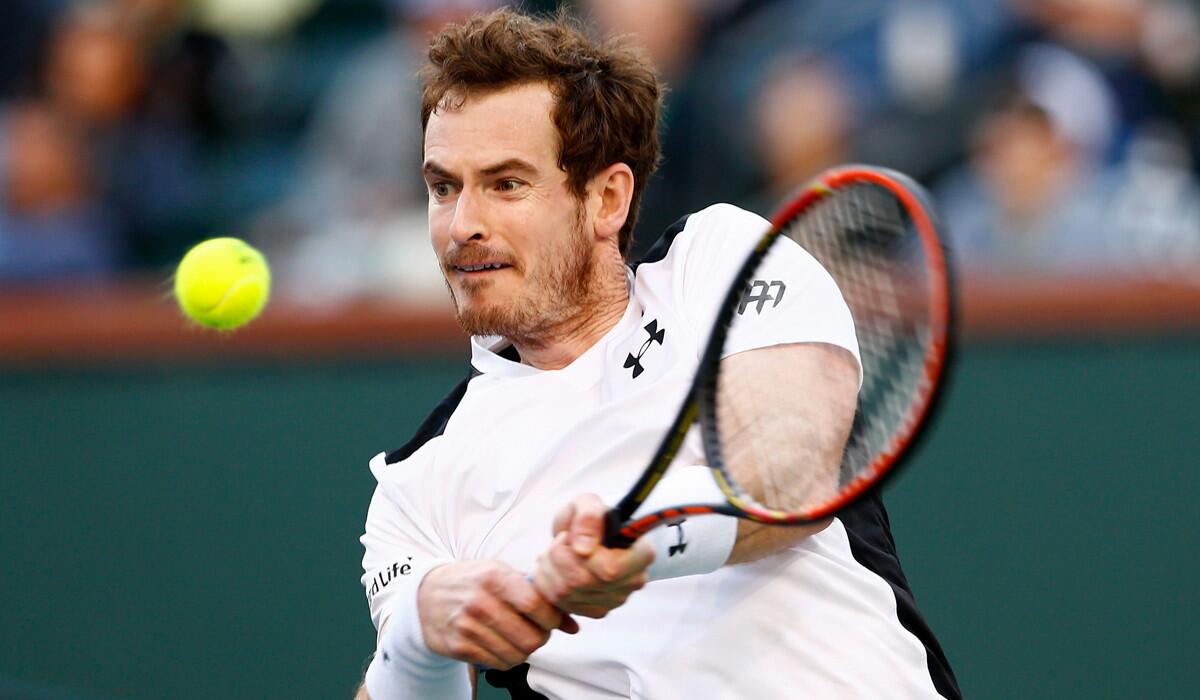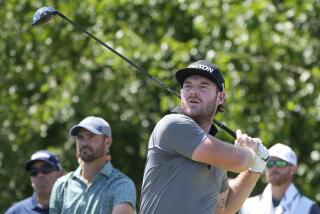Andy Murray adapts and advances at BNP Paribas Open

Andy Murray in action against Marcel Granollers during day six of the BNP Paribas Open at Indian Wells Tennis Garden on Saturday.
- Share via
The BNP Paribas Open has never been kind to Andy Murray. The best result the world’s No. 2 tennis player has achieved at Indian Wells was being the runner-up to Rafael Nadal in 2009, which he followed with a quarterfinal exit in 2010 and back-to-back opening-round losses before he made it back to the semifinals a year ago, where he lost to eventual champion Novak Djokovic.
Whether that will change will be determined in the next week. But on Saturday, at least, he showed that on the court — as in his life — he’s capable of adapting to change.
Fending off variable winds on the Stadium 1 court, Murray defeated Spaniard Marcel Granollers, 6-4, 7-6 (3) in a second-round match. By the end they were matching each other grunt for grunt, but Murray prevailed the way he so often does: with patience, speed, and great tactics. And his newfound adaptability.
“The end we walk on to the court from, you were playing into the wind. It’s such a huge contrast from one end to the other because of how the air is here,” he said. “So when you’re playing with the wind it’s really flying on you and you feel like if you barely touch the ball it’s flying a lot. Then from the other side, you know, it’s completely opposite. You really need to give the ball a big, big hit to get it deep.
“Much different conditions to what I have obviously been practicing and playing in, in the last five weeks, against a tough sort of unorthodox player.”
Granollers pushed him in the second set and had two break points in the eighth game before Murray held serve. Granollers saved three break points in the 11th game and took a 6-5 lead, but Murray won the next game at love and pulled away in the tiebreaker, finishing it with a cross-court forehand.
“He’s got quite a different game. He’s a very smart player, as well, intelligent player, and often makes the right decisions,” Murray said. “Yeah, made it tough for me.”
But it wasn’t too tough for him to succeed in a previously hostile venue. “I haven’t necessarily played my best here over the years, but I think because the conditions are extremely lively and the balls here are so, so fast, that I don’t know,” Murray said.
“Maybe the quality of tennis isn’t as high as it is in other places when it’s a bit slower. I think when the conditions are calm, you know, I think the quality of tennis is high. But when it gets windy here it can be difficult to play really well, I think. It does make it challenging.”
Murray has recently had a lot of practice at handling change and challenges.
The most profound change occurred when he and his wife, Kim, became parents of a daughter, Sophia, on Feb. 7. He struggles with being away from the baby, though he said Kim will bring her to the ATP Tour Masters 1000 event later this month in Miami.
“It’s been the best thing that’s happened in my life so far and hopefully that continues,” he said a few days ago. “If it doesn’t have a positive effect on my tennis, that’s fine. I’m still very glad that I’ve done it.”
The other major adjustment involved his coaching team.
Amelie Mauresmo remains his primary coach and will be on the road with him 22 to 24 weeks this year but he’s no longer working with Jonas Bjorkman. Instead, Murray brought on former British Davis Cup player Jamie Delgado, who lives near Wimbledon and is available on a more consistent basis.
“I wanted to have a coach spend a lot of time with me on the road who was basically at all of the tournaments with me,” Murray said. “Last year with Amelie and Jonas, they are splitting a lot of the time and I wasn’t really having any real continuity on the coaching side. It was sort of two weeks with one, one week with the other, you know, and then maybe a week of training in London on my own. I didn’t have anyone near — well, in London where I live.
“Having someone like Jamie who is like 20 minutes up the road from me, it just means that every time I’m home and I’m training, now having a kid and probably spending more time at home it’s good for me to have someone like him around 35, 40 weeks of the year, to have that continuity.”
After all that change, continuity might look very good.
Twitter: @helenenothelen
More to Read
Go beyond the scoreboard
Get the latest on L.A.'s teams in the daily Sports Report newsletter.
You may occasionally receive promotional content from the Los Angeles Times.










